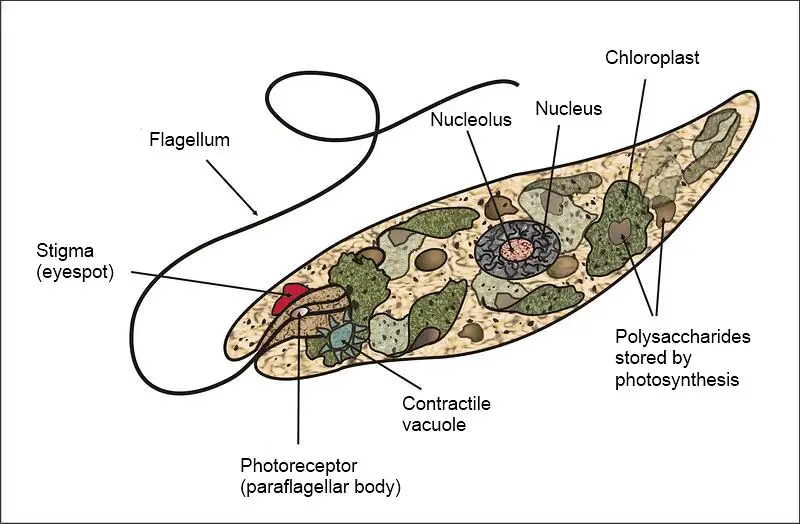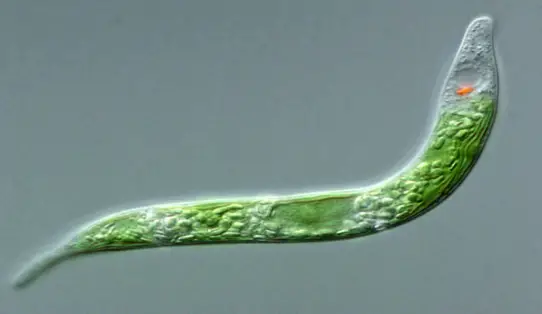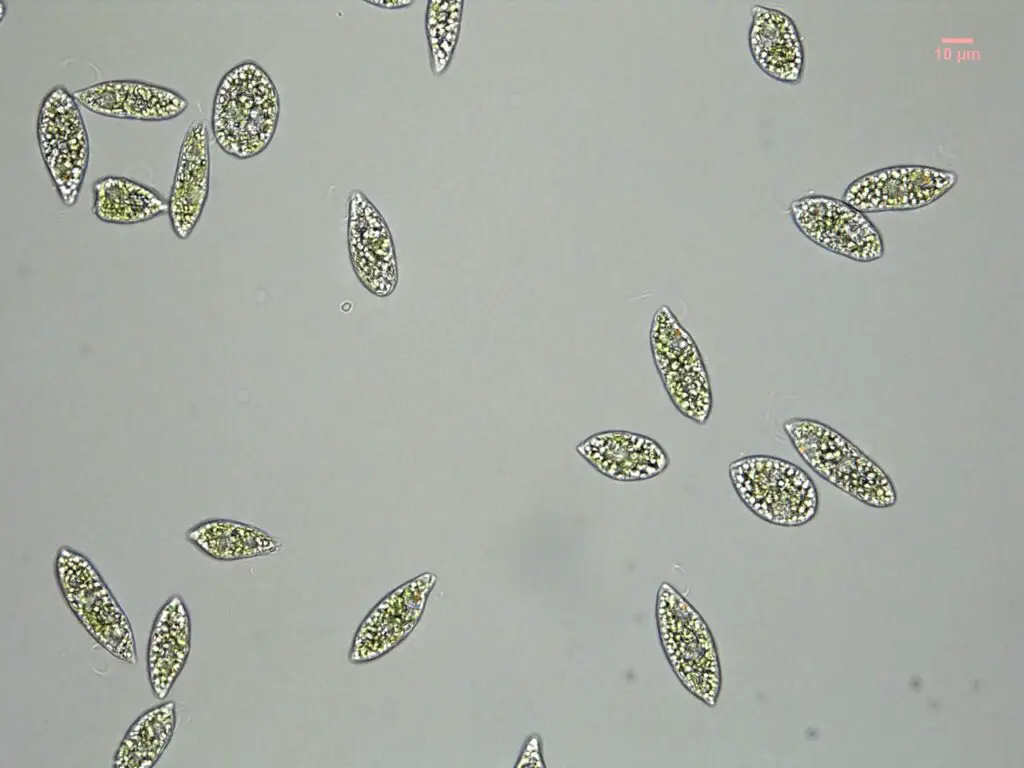How does Euglena eat? (Nutrition in Euglena)
Eating in general means putting the food in the mouth and swallowing it. Euglena doesn’t have a mouth and so they can’t swallow food.
Eating in Euglena is more of like consuming (absorbing). In fact, they consume (absorb) the sunlight to produce food autotrophically. Or, they use their Pellicle to consume (absorb) dead organic matter to produce food saprophytically.
Euglena is a simple, unicellular, eukaryotic, and flagellated organism that is called autotrophic organisms as they can produce their own food with the help of photosynthesis using their chloroplasts.
And, they can also depend upon the other living organisms as saprophytes by feeding on organic dead and decaying matter by absorbing it from the surrounding water using their pellicle.
We all know that Euglena is the connecting link between the Plant and Animal kingdom. So, this organism possesses the characters of the plant as well as the animals.
This can also be seen in how they eat food that is, in their nutrition as well. So, they are also considered as Mixotrophs meaning that they are both Autotrophs and Heterotrophs.
They are called Autotrophs because they can produce their own food. The chloroplasts in Euglena gives it the ability to provide nutrients for itself through the process of photosynthesis.
They are Heterotrophs because when they lose their chlorophyll, they show the saprophytic type of nutrition as well, meaning that they rely on dead decaying organic matter to get their food and nutrition, rather than producing their own as autotrophs do.
In recent years, Scientists are researching for Holozoic type of nutrition in Euglena.
Holozoic is a particular type of animal-like nutrition in which nourishment is obtained by feeding (ingestion) of plants or other animals and then by the processing of gaseous, liquids, or solid food particles into simple ones.
But at present, there is no such strong evidence of animal-like or holozoic nutrition in Euglena.
In this post, we will not only talk about eating but regarding nutrition as well. Nutrition involves more than simply eating and it is about nourishment on every level.

Euglena viridis (Image Source- Flickr)
How does Euglena eat? Nutrition in Euglena is of 2 types:
- Holophytic or Autotrophic Nutrition: Using Chloroplast they produce food from sunlight, water, carbon dioxide, or other chemicals.
- Saprophytic or Saprozoic Nutrition: Using Pellicle they derive their food from dead and decaying matter.
1. Holophytic or Autotrophic Nutrition
Autotrophic Nutrition is the chief mode of nutrition in Euglena. Euglena uses their chloroplasts to produce nutrients for their daily needs through photosynthesis.
Chloroplasts are organelles found in the cells that conduct photosynthesis for the natural food preparation in plants. Chloroplasts absorb and utilize sunlight and use it in along with water and carbon dioxide gas to produce food for the plant.
Chloroplasts contain the green pigment called chlorophyll which is located within the thylakoid membrane of the chloroplast. This chlorophyll helps in photosynthesis.
Chloroplasts due to the chlorophyll also causes the green coloured appearance to the Euglena.
In Euglena, the chlorophyll pigment absorbs energy from the sunlight. Then, with the help of sunlight energy the Water (H2O) reacts with Carbon dioxide (CO2) in a series of steps forming a Hexose Sugar.
This Hexose Sugar is then transformed into a type of polysaccharide, called paramylum or paramylon.
It is very important to note that, Polysaccharide paramylum is not a true starch, as it does not turn blue in the Iodine solution test. Whereas, any true starch produced by plants turns blue in Iodine solution.
Paramylum is a polymer made by Euglena to store energy. They use energy from sunlight to make a simple sugar, glucose.
They then hook glucose molecules all together in such a way that the long-chain curls all around and forms a big globby polymer-like paramylum.
This paramylum is stored up for future use with being either scattered in the form of refractile granules in the endoplasm or, deposited around one or more proteinaceous bodies, the pyrenoids.
Paramylum is mostly seen in abundance in those Euglenoids only that are actively involved in photosynthesis during the day sunlight.

2. Saprophytic or Saprozoic Nutrition
Saprophytic or Saprozoic Nutrition is performed by those Euglena species that have lost their chlorophyll due to its living in the regions of prolonged darkness.
Like for example: Inside the rocks, under the shade in any aquatic environment where sunlight couldn’t penetrate.
Due to the absence of sunlight, they can’t produce food by photosynthesis and so loses their chlorophyll pigment and so losses the green coloured appearance of the body as well.
It becomes etiolated that is, the body becomes pale or white in colour, yet it continues to live and perform all of the life activities.
In such a case, the Saprophytic or Saprozoic Nutrition of Euglena comes into place.
In the Saprophytic mode of nutrition, the Euglena gets its food from the products of decaying organic substances that are dissolved in the surrounding water are absorbed through its general body surface (mainly through the pellicle).
Euglena doesn’t possess a cell wall. It has a pellicle layer instead of a cell wall. This pellicle layer is made up of a protein along with the substructure of microtubules, arranged in strips spiraling around the cell.
The Euglena surrounds the particle of food and consumes it by phagocytosis, or in other words, engulfing the food through its Pellicle layers and then takes it inside through the cell membrane.
It is being researched that Euglena secretes various digestive enzymes that are typically animal-like in nature.
These enzymes do help in the breakdown of dead organic matter into simple molecules for the derivation of food, nutrition, and proper energy.

This is an image of several Euglena gracilis cells taken using light microscopy.
Ellis O’Neill / CC BY-SA
How does Euglena get their food? (Short Answer)
Euglena possesses both kinds of nutrition. This makes it kind of unique in nature. It can acquire food both heterotrophically (by directly consuming food) and autotrophically (by making its own food).
Chloroplasts within the Euglena are chemically equipped to be able to trap the sunlight for performing photosynthesis. Chloroplasts can be seen as several rod-like structures throughout the cell.
Also, you will find an eyespot at the anterior end of the Euglena i.e near the reservoir. This eyespot allows the organism to detect sunlight. This helps the euglena find bright areas to gather sunlight to make their food through photosynthesis.
Euglena can also gain nutrients by absorbing them across their cell membrane, hence they become heterotrophic in the absence of sunlight. It’s because in the absence of sunlight they cannot photosynthesize.
Euglena has a stiff pellicle outside their cell membrane. This helps them keep their shape and structure intake while giving the body its flexibility and elasticity.
And, some Euglena can be observed scrunching up and moving in an inchworm type fashion using the pellicle.
This pellicle also helps in the heterotrophic absorption of food into the body.
Another noteworthy thing is that Pinocytosis has also been observed to take place at the base of the reservoir in the anterior end of the Euglena.
Pinocytosis is actually the process of ingestion of liquid into a cell by the budding of small vesicles from the cell membrane.
Pinocytosis in Euglena helps in the intake of proteins and other large molecules inside the body.
